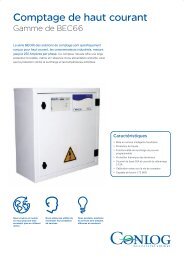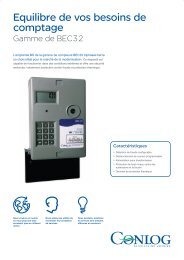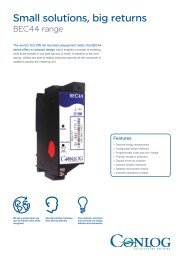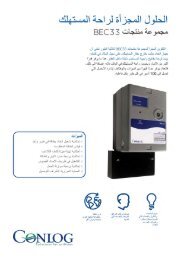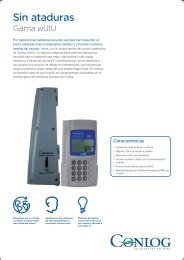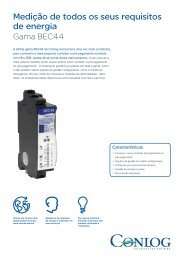VIEW: Sustainable Revenue: An introduction to prepayment - Conlog
VIEW: Sustainable Revenue: An introduction to prepayment - Conlog
VIEW: Sustainable Revenue: An introduction to prepayment - Conlog
Create successful ePaper yourself
Turn your PDF publications into a flip-book with our unique Google optimized e-Paper software.
<strong>Sustainable</strong> revenue<br />
<strong>An</strong> <strong>introduction</strong> <strong>to</strong> <strong>prepayment</strong>
Introduction<br />
Welcome <strong>to</strong> the world of electricity <strong>prepayment</strong>. This document<br />
provides an overview on the basic principles of <strong>prepayment</strong>, with<br />
specific focus on the <strong>Conlog</strong> products and services.<br />
Prepayment is not a new concept, however the popularity of<br />
electricity <strong>prepayment</strong> has significantly increased as people<br />
become more aware of their electricity usage and the associated<br />
costs. Further, the global demand for prepaid cellular services, has<br />
enabled <strong>prepayment</strong> <strong>to</strong> become an easily unders<strong>to</strong>od concept.<br />
In simple terms, prepaid electricity is no different <strong>to</strong> prepaid<br />
cellular airtime, whereby a consumer purchases their<br />
electricity requirements up-front, prior <strong>to</strong> consumption. When they<br />
have consumed the electricity, they simply <strong>to</strong>p-up with another<br />
purchase. If no new electricity purchase is made, the supply is<br />
suspended.<br />
“<br />
The popularity of electricity <strong>prepayment</strong><br />
has significantly increased...<br />
“<br />
2
Overview of a <strong>prepayment</strong> solution<br />
A <strong>prepayment</strong> system, or solution, comprises three manda<strong>to</strong>ry components:<br />
> Prepaid meters: the measurement and metering device<br />
> Vending system: a system that consumers visit <strong>to</strong> purchase electricity<br />
requirements<br />
> <strong>Revenue</strong> management system: installed at the utility <strong>to</strong> manage the<br />
<strong>prepayment</strong> infrastructure<br />
There are then additional aspects, that are optional, yet highly recommended:<br />
> Support services: comprise service level agreements, maintenance<br />
contracts and onsite support as required<br />
> Training: accredited training in all aspects of <strong>prepayment</strong>, <strong>to</strong> ensure<br />
transfer <strong>to</strong> knowledge and skills <strong>to</strong> utility personnel<br />
> Consulting and project management: effective in providing on-the-ground<br />
expertise and guidance for the deployment of <strong>prepayment</strong><br />
This document will focus on providing more information on the three<br />
manda<strong>to</strong>ry components of <strong>prepayment</strong>.<br />
The first step in the process is <strong>to</strong> install and commission the vending and<br />
management system. The vending unit(s) should be installed in close<br />
proximity <strong>to</strong> the cus<strong>to</strong>mers, while the management and vending server is<br />
installed in the utility offices.<br />
<strong>Conlog</strong> undertakes the installation of the computer software and systems, <strong>to</strong><br />
ensure that all the necessary elements are incorporated, such as the tariff<br />
rates and indexes, any arrears collection or data migration from an existing<br />
system.<br />
Once this is completed, meter installation can begin. Remember, consumers<br />
can only purchase electricity once the vending system has been installed.<br />
Consumers are registered on the management system, by assigning an<br />
account and a meter <strong>to</strong> the individual. The meter is then installed by a qualified<br />
electrician and a certificate of compliance/or installation is issued.<br />
The consumer information is au<strong>to</strong>matically downloaded in<strong>to</strong> the vending unit,<br />
so that purchases can be made by giving the meter serial number, or account<br />
number.<br />
“<br />
<strong>Conlog</strong> undertakes the installation of the<br />
computer software and systems...<br />
“<br />
3
Putting the solution <strong>to</strong>gether<br />
Management System<br />
Vending<br />
channels<br />
Online<br />
20 digit<br />
STS <strong>to</strong>ken<br />
Consumer<br />
Vending server with<br />
security module<br />
Cash<br />
Using <strong>prepayment</strong><br />
> The consumer goes <strong>to</strong> a vending site and gives the vendor<br />
the amount of money they want <strong>to</strong> purchase for electricity,<br />
along with the meter serial number or meter swipe card.<br />
> The vendor creates the transaction on the vending unit<br />
and returns a <strong>to</strong>ken (often a paper receipt), comprising 20<br />
digits, <strong>to</strong> the consumer.<br />
> The transaction is au<strong>to</strong>matically recorded in the<br />
management system at the utility’s office.<br />
> The consumer takes the <strong>to</strong>ken back <strong>to</strong> their premises, and<br />
enters the 20-digits in<strong>to</strong> the meter via the keypad.<br />
> The consumer now has electricity. As the user consumes<br />
electricity, the meter will deplete the credit. When it nears<br />
the end of the credit, the meter will alert the user. If no<br />
additional credit is purchased, the meter will suspend the<br />
supply. The consumer will have <strong>to</strong> purchase another <strong>to</strong>ken<br />
before power is au<strong>to</strong>matically reconnected<br />
4
Understanding electricity<br />
There are three key steps <strong>to</strong> the electricity industry:<br />
> Generation: where the electricity is made<br />
> Transmission: transporting the electricity<br />
> Distribution: supplying electricity <strong>to</strong> the end user<br />
Electricity is generated at the power plant, however <strong>to</strong> solve the problem<br />
of sending electricity over long distances a transformer is used. This<br />
changes the electricity from low voltage <strong>to</strong> high voltage, as you can move<br />
electricity more efficiently over long distances if it is high voltage.<br />
The long thick transmission lines carry the high voltage electricity across<br />
the country in<strong>to</strong> substations near businesses, fac<strong>to</strong>ries and homes. At the<br />
substation the transformer steps-down the high voltage and changes it <strong>to</strong><br />
low voltage electricity.<br />
The electricity is then sent <strong>to</strong> the end user through distribution lines, which<br />
have another transformer on the pole <strong>to</strong>p <strong>to</strong> further step-down the voltage,<br />
before being connected <strong>to</strong> the property.<br />
Power plant<br />
generates electricity<br />
Transmission lines carry<br />
electricity long distances<br />
Distribution line carries<br />
electricity <strong>to</strong> house<br />
Transformer<br />
steps up voltage<br />
for transmission<br />
Substation<br />
transformer steps<br />
down voltage<br />
Transformer on pole steps<br />
down voltage before<br />
entering house<br />
Generation Transmission Distribution<br />
Distributing electricity <strong>to</strong> households<br />
Power stations supply three-phase electricity, as this is a more consistent<br />
electrical power and can be transported effectively as they can provide three<br />
times more electricity, without having <strong>to</strong> increase the thickness of the wires.<br />
Three phase electricity is traditionally used for industry, offices and<br />
fac<strong>to</strong>ries, where they need more power than a home user. These<br />
businesses would receive a full three-phase supply, along with one<br />
neutral wire.<br />
However, homes don’t need as much power and therefore only<br />
one phase of the three-phase supply is used per household. The<br />
three-phase cables come down the street and individual phases<br />
are taken <strong>to</strong> supply electricity in<strong>to</strong> the house, along with a neutral.<br />
This is a<br />
single phase<br />
230VAC system<br />
This is a<br />
three phase<br />
280VAC 4 wire system<br />
5
Understanding amps, volts and watts<br />
Think of electricity flowing through a wire, just like water flows through<br />
a hosepipe.<br />
The amps are how much electricity (or current) passes through a set<br />
point. For example, how much water (volume) passes through the end of<br />
the hosepipe, or any specific point along the hosepipe.<br />
The voltage (or electromotive force) that causes the electricity <strong>to</strong> flow<br />
through the wire, is the same as the pressure at the water tap which<br />
causes the water <strong>to</strong> flow.<br />
You turn on the tap and the high pressure at one end of the hose pushes<br />
out the water <strong>to</strong> the other end, where the pressure is lower. Voltage is the<br />
same, where electric current travels from one end of a wire <strong>to</strong> another.<br />
Further, if you increase the pressure at the tap by opening the tap completely,<br />
more water will flow in<strong>to</strong> the hose. In the same way, if we increase<br />
the voltage, more electricity flows in the wire. Turn the tap off, the water<br />
flow s<strong>to</strong>ps. Same again with an electrical circuit, where if we remove the<br />
voltage source, no electricity will flow in the wires.<br />
Meanwhile the amount of water you use would be the watts (or power) in<br />
electricity. If you increase the amps or the voltage, it will result in higher<br />
power.<br />
Amps, or current: the ‘flow rate’ of electricity that passes through a point<br />
Voltage, or electromotive force: the ‘pressure’ of electricity between two<br />
points<br />
Amount of water at<br />
set point = amps<br />
Pressure<br />
between the<br />
two points =<br />
voltage<br />
Consumption of<br />
water = watts<br />
6
How is electricity priced?<br />
The price of electricity is traditionally set by the relevant Government authority<br />
or regula<strong>to</strong>r. This price is then implemented by the utility for all consumers.<br />
<strong>Conlog</strong> has no control over the price of electricity charged by any cus<strong>to</strong>mer.<br />
Some common terminology used when discussing the price of electricity:<br />
> Tariff: refers <strong>to</strong> the price of electricity. See Tariff Index for more<br />
information on this.<br />
> Straight tariff: this is when the utility charges a fixed flat rate for<br />
electricity, no matter the volume or time frame that electricity is purchased.<br />
> Inclining tariff: in South Africa this is called the Incline Block Tariffs or<br />
IBT, but all inclining tariffs operate on a similar principle, whereby a<br />
consumer will pay slightly more for their electricity, the greater the volume<br />
they purchase through the month. Through the month there may be a<br />
number of blocks, for example, block one is for 3KWh, block two is 6KWh,<br />
block three is 9KWh and so on, with each block being slightly more<br />
expensive.<br />
In addition, the process <strong>to</strong> move from one block <strong>to</strong> another is<br />
au<strong>to</strong>matic and depends only on the amount of electricity purchased,<br />
not whether you purchase electricity over many transactions, or in<br />
one large transaction – the result will be the same. At the end of the<br />
month (or defined period), the cost will drop back down <strong>to</strong> block one<br />
and the incrementing price will again continue through the month.<br />
> Free basic electricity / poverty tariff: this is a free allocation of<br />
electricity that is given by the Utility, normally each month and <strong>to</strong> a specific<br />
value.<br />
> Arrears collection: many Utility’s utilise arrears collection as part<br />
of the <strong>prepayment</strong> tariff, whereby a consumer owes money <strong>to</strong> the<br />
Utility, for example, for their previous conventional account. When the<br />
consumer purchases an electricity <strong>to</strong>ken, a percentage is redeemed<br />
against the debt i.e. a purchase of 100, may have 10% taken (10) <strong>to</strong><br />
pay off the debt and the consumer will receive 90 units of electricity.<br />
> Service charges: manda<strong>to</strong>ry service charges, such as refuse or rates,<br />
can also be incorporated in<strong>to</strong> the tariff. For example, a flat service charge<br />
is levied at the first purchase each month. Should a consumer not<br />
purchase, these levies would accumulate and be deducted at the next<br />
purchase.<br />
“<br />
The price of electricity is traditionally set<br />
by the relevant Government...<br />
“<br />
7
“<br />
Meters are available in a variety of<br />
different installation footprints...<br />
“<br />
Understanding the meters<br />
Most meters are available in a variety of different installation footprints, the most<br />
common of which are mentioned here:<br />
> DIN rail: this is a standard type of metal rail that is widely used for mounting<br />
circuit breakers. This is a popular footprint for prepaid meters as many meters<br />
can be installed <strong>to</strong>gether in one enclosure. The term DIN derives from the<br />
original specification published by Deutsches Institut fur Normung (DIN) in<br />
Germany, which was then adopted worldwide.<br />
> ANSI base: used in America and the American terri<strong>to</strong>ries, this glass encased<br />
meter is easily identified by its circular shape<br />
> BS footprint: previously referred <strong>to</strong> as BS7856, or British Standard, this is<br />
traditionally used for retrofitting an existing conventional meter, and refers <strong>to</strong><br />
the wiring of the terminal block as well as the three mounting screws<br />
> Common base: this is a South African standard where the metering device<br />
comprises a two-part housing – a base and the meter. The base is installed<br />
in advance of the meter and when a meter needs <strong>to</strong> be installed, or removed<br />
for any reason, it is simply clipped in<strong>to</strong> the base.<br />
In addition <strong>to</strong> the metering footprint, there are two installation types for<br />
<strong>prepayment</strong> meters:<br />
> Split meter: this is a term <strong>to</strong> describe where a meter is installed outside the<br />
premises, such as on a pole or in a street meter kiosk, and a keypad is<br />
placed in the consumer’s home. This provides additional security for a utility<br />
as the consumer does not have access <strong>to</strong> the meter. Communication between<br />
the meter and the keypad can occur via two core cable, or wirelessly through<br />
radio frequency.<br />
> Combo meter: this is a combination device, whereby the meter and keypad<br />
are designed as one unit. The meter would be installed in the consumer’s<br />
premises, normally next <strong>to</strong> the distribution board.<br />
These meters are then available in single phase and three phase variants.<br />
Split meter<br />
Combo meter<br />
8
Understanding the vending system<br />
Internet Vending<br />
Utility Office<br />
Retailer Vending<br />
Scratch card<br />
Vending<br />
Vending Server<br />
Security Module<br />
ATM Vending<br />
The vending system comprises of a vending server and<br />
vending units. The vending server is normally housed<br />
in the utility’s IT server room, while the vending units are<br />
installed at various points in the <strong>to</strong>wn or region, as this is where<br />
consumers will go <strong>to</strong> purchase their electricity.<br />
The vending server will have a security module attached <strong>to</strong><br />
the computer. The security module is a critical component of<br />
the <strong>prepayment</strong> solution and must always be kept in a secure<br />
area, with limited access. The vending server controls and<br />
records all transactions from the various vending units.<br />
The vending units can be located in a shop, a utility’s<br />
revenue hall or even a local retailer. The s<strong>to</strong>re, or person,<br />
operating the vending system is normally called a ‘vendor’.<br />
The vending system can be one, or many, of the following<br />
devices:<br />
> Computer: a purpose-supplied computer with vending<br />
software<br />
> POS devices: point-of-sale device, similar <strong>to</strong> a credit card<br />
machine<br />
> Internet: enabling registered consumers <strong>to</strong> purchase<br />
electricity via the web<br />
> Scratch card: similar <strong>to</strong> prepaid cellular airtime, the<br />
consumer purchases an electricity scratch card and sends<br />
a text message <strong>to</strong> redeem the value<br />
> Self service terminal: a free standing device that<br />
consumers can purchase electricity from<br />
> ATM: utilising the au<strong>to</strong>mated teller machines of banks,<br />
which offer consumers the ability <strong>to</strong> purchase electricity as<br />
quickly as drawing cash<br />
> Third party merchants: partners who have their own<br />
network of retailers.<br />
The entire vending system is ‘online’. This means that when<br />
a consumer purchases electricity from a vending unit, the<br />
transaction occurs in real time and is recorded immediately<br />
in the vending server.<br />
9
Understanding the<br />
revenue management system<br />
Utility Office<br />
Management Server<br />
Multiple<br />
Management Clients<br />
The revenue management system is the heart of a <strong>prepayment</strong> solution.<br />
A management server is installed within the utility’s IT server room, whilst<br />
utility employees are able <strong>to</strong> access the data via management clients – this can<br />
either be software installed on their computers, or through a web interface.<br />
All data regarding the <strong>prepayment</strong> project, such as the transaction his<strong>to</strong>ry,<br />
cus<strong>to</strong>mer information and meter data, is recorded in real time <strong>to</strong> the<br />
management server, as well as all the security profiles for users.<br />
The revenue management system provides a variety of reports <strong>to</strong> enable a<br />
utility <strong>to</strong> quickly analyse their cus<strong>to</strong>mers, data, income etc. In addition, it is<br />
at the management system that exception reports are generated <strong>to</strong> reveal<br />
potential problematic cus<strong>to</strong>mers or trends.<br />
10
Understanding the terminology<br />
Within the <strong>prepayment</strong> industry, there are fundamental terms that are used which are relevant <strong>to</strong> all<br />
manufacturers and sec<strong>to</strong>rs of the industry.<br />
Commissioning<br />
<strong>Conlog</strong>’s tamper meters have a special function whereby a<br />
meter remains in a “dead” state, so that all the wiring can be<br />
done. Once the installation is complete, the electrician<br />
commissions the meter, by entering a code. The meter is<br />
now active and the electricity is supplied <strong>to</strong> the premises. If<br />
the meter is not commissioned, the consumer will not<br />
receive any electricity.<br />
Initial Credit<br />
When a meter is installed in<strong>to</strong> the premises, the installation<br />
electrician needs <strong>to</strong> test and verify the installation. It is<br />
therefore always advisable <strong>to</strong> load credit at the time of<br />
manufacture, so that the electrician can test and issue a<br />
certificate of compliance/or installation. The normal amount<br />
of initial credit is 5 units, or KWh.<br />
Key Revision Number (KRN)<br />
The Key Revision Number is a number that will change the<br />
entire STS encryption algorithm, which is contained within<br />
the security module. This was designed so that should<br />
anyone be successful in “cracking” a zone, it would simply<br />
require a new Key Revision Number <strong>to</strong> be issued <strong>to</strong> each<br />
meter and the breach would be rectified. However, there has<br />
never been a security breach and therefore this has never<br />
had <strong>to</strong> be used.<br />
Load Limit<br />
Although there must always be an upstream breaker for any<br />
installation, a feature of <strong>Conlog</strong> meters is the ability <strong>to</strong><br />
configure the load limit at the time of manufacture. The<br />
current at which the meter should trip is programmed in<br />
power ratings (KW), not current ratings (Amps).<br />
If the meter must trip at 40 Amps on a supply voltage of<br />
230VAC, it would be programmed <strong>to</strong> trip at 9.2KW. This is<br />
calculated by Power Rating = Supply Voltage x Trip Current<br />
Meter Serial Number<br />
This is a unique 11 digit number and, as governed by the STS<br />
Association, there is no one single electricity <strong>prepayment</strong><br />
meter that has the same serial number. In addition, just as<br />
in the banking industry, there is a luhn check digit contained<br />
in the meter serial number <strong>to</strong> authenticate the serial number.<br />
The meter serial number appears on the front of the<br />
meter and can also be accessed by entering a short code<br />
(also called hash command) in<strong>to</strong> the meter. The meter<br />
serial number also appears on the meter swipe card that is<br />
shipped with every meter.<br />
Security Module<br />
This device is a manda<strong>to</strong>ry item for any <strong>prepayment</strong> project.<br />
Further, as it is the device that undertakes the encryption<br />
security and is vital for vending <strong>to</strong> occur, it should be kept<br />
under extremely secure conditions with highly<br />
restricted access. The industry often refers <strong>to</strong> the device<br />
as an “au<strong>to</strong>mated teller machine” or “money printer” and as<br />
such, should be kept safe.<br />
The security module will have the cus<strong>to</strong>mer’s SGC(s) loaded<br />
on the device, along with the STS algorithm, in order <strong>to</strong><br />
generate <strong>to</strong>kens from a vending server. The device is<br />
attached <strong>to</strong> the vending server.<br />
The housing of the module is designed that should<br />
someone attempt <strong>to</strong> tamper or force open the device, it will<br />
self-terminate.<br />
11
STS Association<br />
The world’s first open source, globally accepted<br />
standard for <strong>prepayment</strong> is STS, also known as the<br />
Standard Transfer Specification, which is governed by the<br />
STS Association. This standard has been adopted by the<br />
International Electrotechnical Commission (IEC) and is<br />
currently being integrated in<strong>to</strong> other smart/AMI standards<br />
globally.<br />
STS is an encryption methodology <strong>to</strong> enable the secure<br />
transfer of information from the vending system <strong>to</strong> the meter.<br />
STS also ensures that any credit <strong>to</strong>ken (purchase of electricity)<br />
is only valid for that specific meter, thus reducing fraud or theft.<br />
The encryption security is similar <strong>to</strong> that used in the banking<br />
infrastructure and, in over 20 years, the system has never<br />
encountered a breach.<br />
The benefit of ensuring a STS compliant system is that<br />
because it is open source, a utility is not locked <strong>to</strong> one<br />
supplier’s proprietary system. This means that the<br />
utility can change suppliers or products, without high<br />
expense. In addition, the industry as a general will<br />
advance more rapidly as competition is encouraged.<br />
Tamper<br />
The term tamper refers <strong>to</strong> people who are trying <strong>to</strong> illegally<br />
receive electricity without paying. This takes many forms,<br />
however our meters have enhanced tamper functionality<br />
which assists in addressing this problem.<br />
Token<br />
A <strong>to</strong>ken refers <strong>to</strong> the 20-digit number issued from a vending<br />
point, that is entered in<strong>to</strong> the meter <strong>to</strong> receive electricity. The<br />
<strong>to</strong>ken, or voucher, may take the form of a printed receipt,<br />
a text message on a cellphone, or a number received over<br />
the internet. This <strong>to</strong>ken is generated for a specific meter<br />
and cannot be entered in<strong>to</strong> any other meter – should that<br />
occur, the meter will reject the <strong>to</strong>ken and the individual will<br />
not receive electricity.<br />
Supply Group Code (SGC)<br />
Often referred <strong>to</strong> as the SGC, this is a unique number<br />
given <strong>to</strong> each cus<strong>to</strong>mer, such as a utility, municipality, or<br />
even a housing complex. The purpose of the SGC is <strong>to</strong><br />
create a zone, in<strong>to</strong> which all cus<strong>to</strong>mers’ meters belong and<br />
the consumer can only purchase electricity from that zone.<br />
The SGC is supplied by the STS Association and forms<br />
part of the security encryption process. A new <strong>prepayment</strong><br />
cus<strong>to</strong>mer must formally request a SGC from the STS<br />
Association, which is then loaded in<strong>to</strong> the security module,<br />
<strong>to</strong> enable the vending of <strong>to</strong>kens. If there is no SGC, you<br />
cannot vend <strong>to</strong>kens.<br />
In addition, in order for any manufacturer <strong>to</strong> build meters, the<br />
cus<strong>to</strong>mer must give written approval for the SGC <strong>to</strong> be given <strong>to</strong><br />
the supplier, as the SGC forms part of the production security.<br />
Tariff Index<br />
The tariff rate is a financial calculation that<br />
converts a monetary value <strong>to</strong> a unit value (KWh). This<br />
function is done at the vending unit, as the meter does<br />
not s<strong>to</strong>re the actual tariff rate, but only the tariff index.<br />
However, a cus<strong>to</strong>mer may have more than one<br />
tariff rate, for example one charge for a three<br />
phase supply and another charge for single phase<br />
supply. These different tariff rates will be assigned a<br />
separate Tariff Index – the three phase supply would be<br />
assigned Tariff Index 1 and single phase the Tariff Index 2.<br />
When the three phase meter is manufactured, it is<br />
programmed <strong>to</strong> Tariff Index 1. The consumer then<br />
purchases a <strong>to</strong>ken from the vending system, which will be on<br />
Tariff Index 1 and enters the 20-digit <strong>to</strong>ken in<strong>to</strong> their meter<br />
and it is decrypted <strong>to</strong> check the Tariff Index. If for any reason<br />
the Tariff Index is different, for example on Tariff Index 2 for<br />
single phase meters, the <strong>to</strong>ken will be rejected. This avoids<br />
fraudulent transactions, such as a consumer trying <strong>to</strong> purchase<br />
a <strong>to</strong>ken on a different Tariff Index because the rate<br />
is cheaper.<br />
12
P O Box 2332, Durban, 4000, South Africa<br />
Tel +27 (31) 268-1111 Fax +27 (31) 268-1500<br />
www.conlog.co.za<br />
info@conlog.co.za



